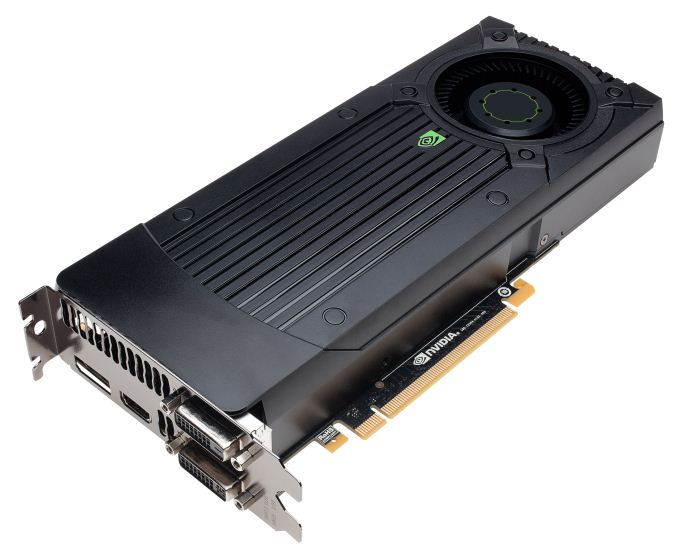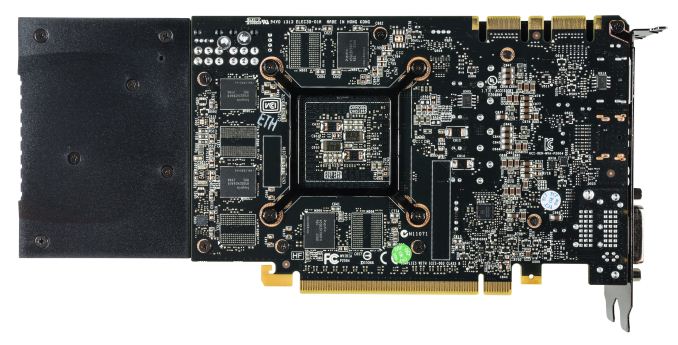NVIDIA GeForce GTX 760 Review: The New Enthusiast Kepler
by Ryan Smith on June 25, 2013 9:00 AM ESTMeet the GeForce GTX 760
As we mentioned earlier, due to its 170W TDP the GTX 760 is essentially a drop-in replacement for the GTX 670 in board designs. Even NVIDIA’s reference design reflects this, with the reference GTX 760 being based on the reference GTX 670’s cooler and PCB. Consequently there’s not much to say about the GTX 760’s design that we haven’t said before. If you’ve seen a GTX 670 then you’ve seen a GTX 760, down to the last screw. For consistency we’ll quickly go over the GTX 760’s design, but this is generally a rehash of what we’ve already said about the GTX 670.
Like GTX 670 before it, GTX 760 is another “small” GK104 design. The complete card is 9.5” long, however the actual PCB is far shorter at only 6.75” long, 3.75” shorter than the GTX 770’s PCB. In fact it would be fair to say that rather than strapping a cooler onto a card, NVIDIA strapped a card onto a cooler. Meanwhile we see that once again NVIDIA is using Hynix R0C (6GHz) GDDR5 RAM here.
The cooler itself is fairly simple, utilizing an aluminum heatsink melded with a copper base plate. A separate heatsink covers the VRM circuitry – once again mounted at the front of the card – while the fan hangs off of the rear of the card. This unfortunately is the same fan as on the GTX 670, which means it makes a faint grinding sound at low RPMs. This design has proven more than adequate for the GTX 670s, though it does leave some room for NVIDIA’s partners to improve on overall cooling performance, especially with open air coolers.
Elsewhere at the top of the card we’ll find the PCIe power sockets and SLI connectors. Two 6-pin PCIe sockets provide the necessary external power, while a pair of SLI bridge connectors at the other end allow for up to 3-way SLI. NVIDIA’s standard I/O configuration also makes an appearance here, offering 2x DL-DVI, 1x HDMI, 1x DisplayPort 1.2.
Looking at clockspeed bins for a moment, it comes as no great surprise that like the GTX 770, the GTX 760 operates at 1.2v at its highest stock clockspeed bin. The higher voltage versus the 1.76v limit on the 600 series causes power consumption to jump up more rapidly at the highest bins, but is necessary to unlock the 1100MHz+ clockspeeds the card is capable of.
| GeForce Clockspeed Bins | ||||
| Clockspeed | GTX 770 | GTX 760 | ||
| 1162MHz | N/A | 1.212v | ||
| 1149MHz | 1.212v | 1.2v | ||
| 1136MHz | 1.2v | 1.187v | ||
| 1123MHz | 1.187v | 1.162v | ||
| 1110MHz | 1.162v | 1.15v | ||
| 1097MHz | 1.15v | 1.137v | ||
| 1084MHz | 1.137v | 1.125v | ||
| 1071MHz | 1.125v | 1.112v | ||
| 1058MHz | 1.112v | 1.1v | ||
| 1045MHz | 1.1v | 1.087v | ||
Finaly, for overclockers there is one further bin (1162MHz) available via overvolting to 1.212v. The maximum power target meanwhile is 115%, for a final power limit of 195W.
















110 Comments
View All Comments
kishorshack - Tuesday, June 25, 2013 - link
Looks like the GPU gains over a two year cycle is more than CPU gainsSpending on GPU's is more worth while than Spending on CPU's
Specially if you start from Sandy Bridge in CPU's
DanNeely - Tuesday, June 25, 2013 - link
3D Rendering is a trivially parallelizable workload. As a result it can roughly double in performance with each full node process shrink just by keeping the core design the same but putting twice as many of them on the die. Real world behavior differs mostly in that some of the additional die space is used to enable things that weren't practical before instead of just making all the existing features twice as fast.wumpus - Tuesday, June 25, 2013 - link
That is only strictly true if you are willing to use twice as much electricity and generate/remove twice as much heat (it could approach costing twice as much as well, but not nearly as often). A good chunk of each update needs to go to making the GPU have a higher TFLOP/W or the thing will melt.ewood - Tuesday, June 25, 2013 - link
luckily many of those issues are mitigated by transition to a smaller process node, as DanNeeley said. your statement is more applicable to dual die cards, not new processors having twice the functional units.maltanar - Tuesday, June 25, 2013 - link
That is unfortunately no longer true, smaller processes do not benefit from the so-called 'Dennard scaling' anymore, without a lot of trickery from semiconductor engineers.DanNeely - Wednesday, June 26, 2013 - link
They may have to work harder at it; but as long as they're able to continue doing what you refer to as trickery, the result for us end users is the same.tential - Wednesday, June 26, 2013 - link
CPU gains have been made, just not in performance. We don't need performance on the CPU side for a LOT of applications. Like I always say, if you had double the CPU performance, you still wouldn't gain much FPS in most games.Intel would be cannibalizing it's higher end processors if it kept making CPU gains. Instead, it focuses on power consumption, to fit better CPUs into smaller things such as notebooks, tablets, etc. Look at the Macbook Air Review and then tell me we haven't made CPU gains.
UltraTech79 - Tuesday, July 2, 2013 - link
More worthwhile than what? What are you even talking about? Today's i5 chips arnt the bottleneck to any of the GPUs here in any game. So what you're saying is irrelevant.ericore - Tuesday, July 2, 2013 - link
Aint that the truth, the biggest change was from the 500 series to the 600 series.The 600 series make most radeons look like dinosaurs or AMD processors.
Intel is dicking around giving us less than 10% speed inprovement in each generation.
Can't wait for AMD to release their steamroller 8 core, except where latency is crucial it will match haswell and cost a fraction. Haswell will still technically be faster, but only in benchmarks, in practice they will be identical. The change from piledriver to steamroller is like from a a pentium 4 to a core 2 duo. It's not a new architecture, but has so many improvements that it ought to be called one.
MarcVenice - Tuesday, June 25, 2013 - link
I checked all the games, and the first 4-5 games the 7950 Boost wins, the other the GTX 760 wins. I didn't add up the numbers, but are you guys sure the HD 7950 Boost is 8% slower overall?And what's anandtech's stance on frametimes/fcat? Are those only used when problems arise, new games? I realize they take a lot of time, but I think they can be quite valuable in determing which card is the fastest.